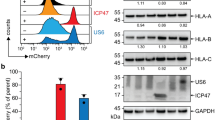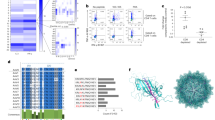Abstract
Oncolytic adenoviruses can promote immune responses against tumors by expressing and/or displaying tumor-associated antigens. However, the strong immunodominance of viral antigens mask responses against tumor epitopes. In addition, defects in major histocompatibility complex class I antigen presentation pathway such as the downregulation of the transporter-associated with antigen processing (TAP) are frequently associated with immune evasion of tumor cells. To promote the immunogenicity of exogenous epitopes in the context of an oncolytic adenovirus, we have taken advantage of the ER localization of the viral protein E3-19K. We have inserted tumor-associated epitopes after the N-terminal signal sequence for membrane insertion of this protein and flanked them with linkers cleavable by the protease furin to facilitate their TAP-independent presentation. This strategy allowed an enhanced presentation of the exogenous epitopes in TAP-deficient tumor cells in vitro and the generation of higher specific immune responses in vivo that were able to significantly control tumor growth.
This is a preview of subscription content, access via your institution
Access options
Subscribe to this journal
Receive 12 print issues and online access
$259.00 per year
only $21.58 per issue
Buy this article
- Purchase on Springer Link
- Instant access to full article PDF
Prices may be subject to local taxes which are calculated during checkout




Similar content being viewed by others
References
Alemany R, Cascallo M . Oncolytic viruses from the perspective of the immune system. Future Microbiol 2009; 4: 527–536.
Woller N, Gurlevik E, Ureche CI, Schumacher A, Kuhnel F . Oncolytic viruses as anticancer vaccines. Front Oncol 2014; 4: 188.
Bartlett DL, Liu Z, Sathaiah M, Ravindranathan R, Guo Z, He Y et al. Oncolytic viruses as therapeutic cancer vaccines. Mol Cancer 2013; 12: 103.
Rodriguez-Rocha H, Gomez-Gutierrez JG, Garcia-Garcia A, Rao XM, Chen L, McMasters KM et al. Adenoviruses induce autophagy to promote virus replication and oncolysis. Virology 2011; 416: 9–15.
Jiang H, White EJ, Rios-Vicil CI, Xu J, Gomez-Manzano C, Fueyo J . Human adenovirus type 5 induces cell lysis through autophagy and autophagy-triggered caspase activity. J Virol 2011; 85: 4720–4729.
Schirmbeck R, Reimann J, Kochanek S, Kreppel F . The immunogenicity of adenovirus vectors limits the multispecificity of CD8 T-cell responses to vector-encoded transgenic antigens. Mol Ther 2008; 16: 1609–1616.
Frahm N, DeCamp AC, Friedrich DP, Carter DK, Defawe OD, Kublin JG et al. Human adenovirus-specific T cells modulate HIV-specific T cell responses to an Ad5-vectored HIV-1 vaccine. J Clin Invest 2012; 122: 359–367.
Leone P, Shin EC, Perosa F, Vacca A, Dammacco F, Racanelli V . MHC class I antigen processing and presenting machinery: organization, function, and defects in tumor cells. J Natl Cancer Inst 2013; 105: 1172–1187.
Lu J, Higashimoto Y, Appella E, Celis E . Multiepitope trojan antigen peptide vaccines for the induction of antitumor CTL and Th immune responses. J Immunol 2004; 172: 4575–4582.
Raafat N, Sadowski-Cron C, Mengus C, Heberer M, Spagnoli GC, Zajac P . Preventing vaccinia virus class-I epitopes presentation by HSV-ICP47 enhances the immunogenicity of a TAP-independent cancer vaccine epitope. Int J Cancer 2012; 131: E659–E669.
Gil-Torregrosa BC, Castano AR, Lopez D, Del Val M . Generation of MHC class I peptide antigens by protein processing in the secretory route by furin. Traffic 2000; 1: 641–651.
Maecker HT, Umetsu DT, DeKruyff RH, Levy S . Cytotoxic T cell responses to DNA vaccination: dependence on antigen presentation via class II MHC. J Immunol 1998; 161: 6532–6536.
Werlen G, Hausmann B, Palmer E . A motif in the alphabeta T-cell receptor controls positive selection by modulating ERK activity. Nature 2000; 406: 422–426.
Overwijk WW, Tsung A, Irvine KR, Parkhurst MR, Goletz TJ, Tsung K et al. gp100/pmel 17 is a murine tumor rejection antigen: induction of "self"-reactive, tumoricidal T cells using high-affinity, altered peptide ligand. J Exp Med 1998; 188: 277–286.
Rojas JJ, Gimenez-Alejandre M, Gil-Hoyos R, Cascallo M, Alemany R . Improved systemic antitumor therapy with oncolytic adenoviruses by replacing the fiber shaft HSG-binding domain with RGD. Gene Ther 2011; 19: 453–457.
Rojas JJ, Guedan S, Searle PF, Martinez-Quintanilla J, Gil-Hoyos R, Alcayaga-Miranda F et al. Minimal RB-responsive E1A promoter modification to attain potency, selectivity, and transgene-arming capacity in oncolytic adenoviruses. Mol Ther 2010; 18: 1960–1971.
Bayo-Puxan N, Gimenez-Alejandre M, Lavilla-Alonso S, Gros A, Cascallo M, Hemminki A et al. Replacement of adenovirus type 5 fiber shaft heparan sulfate proteoglycan-binding domain with RGD for improved tumor infectivity and targeting. Hum Gene Ther 2009; 20: 1214–1221.
Porgador A, Yewdell JW, Deng Y, Bennink JR, Germain RN . Localization, quantitation, and in situ detection of specific peptide-MHC class I complexes using a monoclonal antibody. Immunity 1997; 6: 715–726.
Agrawal S, Reemtsma K, Bagiella E, Oluwole SF, Braunstein NS . Role of TAP-1 and/or TAP-2 antigen presentation defects in tumorigenicity of mouse melanoma. Cell Immunol 2004; 228: 130–137.
Seliger B, Wollscheid U, Momburg F, Blankenstein T, Huber C . Characterization of the major histocompatibility complex class I deficiencies in B16 melanoma cells. Cancer Res 2001; 61: 1095–1099.
Martini M, Testi MG, Pasetto M, Picchio MC, Innamorati G, Mazzocco M et al. IFN-gamma-mediated upmodulation of MHC class I expression activates tumor-specific immune response in a mouse model of prostate cancer. Vaccine 2010; 28: 3548–3557.
Khong HT, Wang QJ, Rosenberg SA . Identification of multiple antigens recognized by tumor-infiltrating lymphocytes from a single patient: tumor escape by antigen loss and loss of MHC expression. J Immunother 2004; 27: 184–190.
Moore MW, Carbone FR, Bevan MJ . Introduction of soluble protein into the class I pathway of antigen processing and presentation. Cell 1988; 54: 777–785.
Winzler C, Rovere P, Rescigno M, Granucci F, Penna G, Adorini L et al. Maturation stages of mouse dendritic cells in growth factor-dependent long-term cultures. J Exp Med 1997; 185: 317–328.
Stanton RJ, McSharry BP, Armstrong M, Tomasec P, Wilkinson GW . Re-engineering adenovirus vector systems to enable high-throughput analyses of gene function. Biotechniques 2008; 45: 659–662; 64–68.
Acknowledgements
Alba Rodríguez was supported by a pre-doctoral fellowship (PFIS) granted by the ‘Instituto de Salud Carlos III’. This work was supported by a BIO2011-30299-C02-01 grant from the ‘Ministerio de Educación y Ciencia’ of the Government of Spain and a 2009SGR283 research grant from the ‘Generalitat de Catalunya’. We gratefully acknowledge the technical support of Elisenda Alsina and Agnés Figueras in quantitative real-time PCR.
Author information
Authors and Affiliations
Corresponding author
Ethics declarations
Competing interests
The authors declare no conflict of interest.
Additional information
Supplementary Information accompanies this paper on Gene Therapy website
Supplementary information
Rights and permissions
About this article
Cite this article
Rodríguez-García, A., Svensson, E., Gil-Hoyos, R. et al. Insertion of exogenous epitopes in the E3-19K of oncolytic adenoviruses to enhance TAP-independent presentation and immunogenicity. Gene Ther 22, 596–601 (2015). https://doi.org/10.1038/gt.2015.41
Received:
Revised:
Accepted:
Published:
Issue Date:
DOI: https://doi.org/10.1038/gt.2015.41
This article is cited by
-
Enhanced antitumor efficacy of an oncolytic adenovirus armed with an EGFR-targeted BiTE using menstrual blood-derived mesenchymal stem cells as carriers
Cancer Gene Therapy (2020)
-
Codon optimization of the adenoviral fiber negatively impacts structural protein expression and viral fitness
Scientific Reports (2016)



